Original title: What Were Watching in 2025 (Crypto AI)
Original author: Teng Yan ( @0xPrismatic )
Compiled by: Asher ( @Asher_0210 )

The future of the crypto AI sector is very attractive. Although there is a lack of historical examples and clear trends, it also means that it is at a brand new starting point, waiting for future development. It will be even more exciting to think about looking back on all this in 2026 and seeing the gap between the expectations at the beginning of 2025 and the actual situation.
1. The total market value of the crypto AI sector will reach $150 billion
Currently, tokens in the crypto AI sector only account for 2.9% of the altcoin market cap, but I believe this proportion will not last long. As artificial intelligence gradually expands to new areas such as smart contract platforms, Meme, decentralized physical infrastructure (DePIN), proxy platforms, data networks, and intelligent coordination layers, its integration with DeFi and Meme tokens has become an inevitable trend.
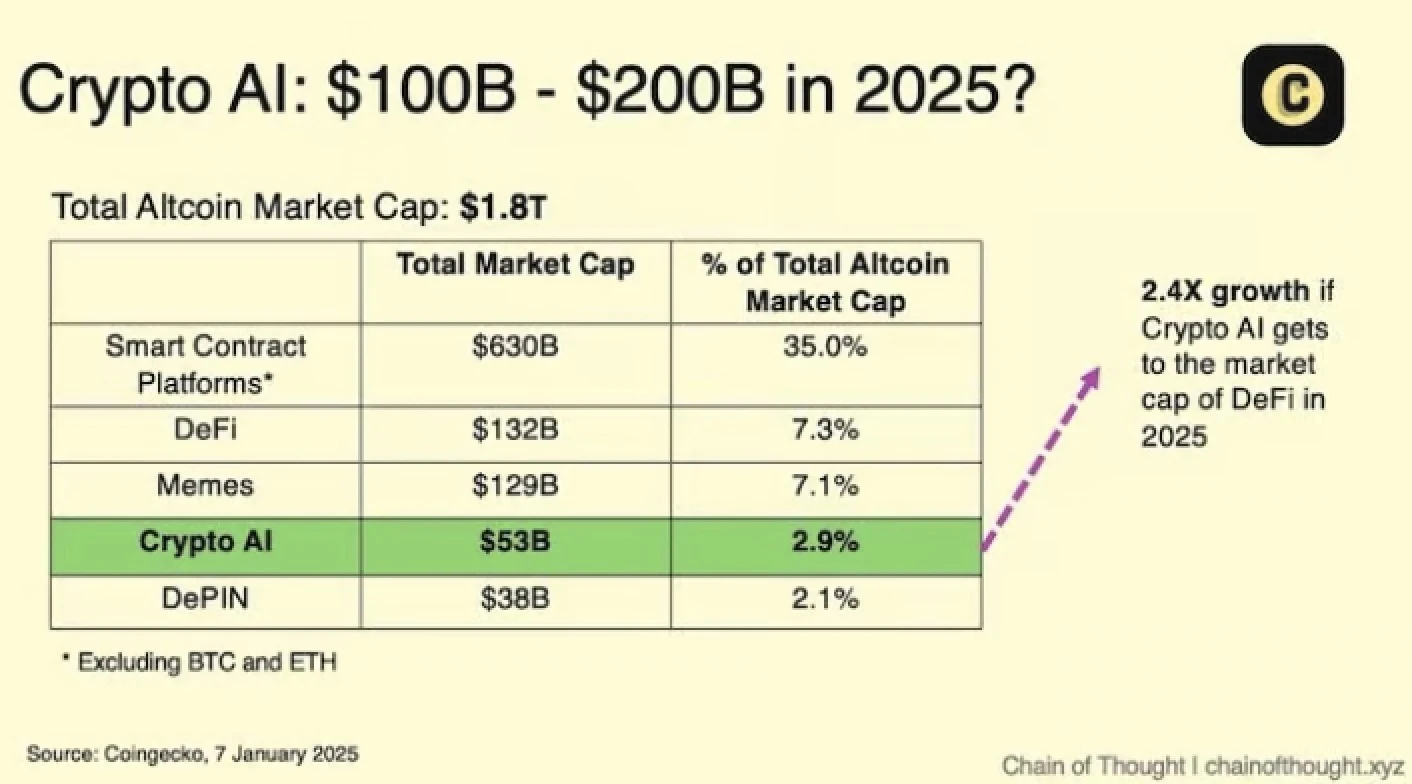
The reason for confidence in the crypto AI sector is that it sits at the intersection of two of the most powerful trends in technology:
AI mania trigger event: OpenAIs IPO or similar events may trigger a global craze for AI. At the same time, Web2s institutional capital is already paying attention to decentralized AI infrastructure as an investment.
Retail Frenzy: The concepts of AI are easy to understand and exciting, and now they can be invested in through tokens. Remember the Meme Coin Gold Rush in 2024? This will be the same frenzy, only AI will actually change the world.
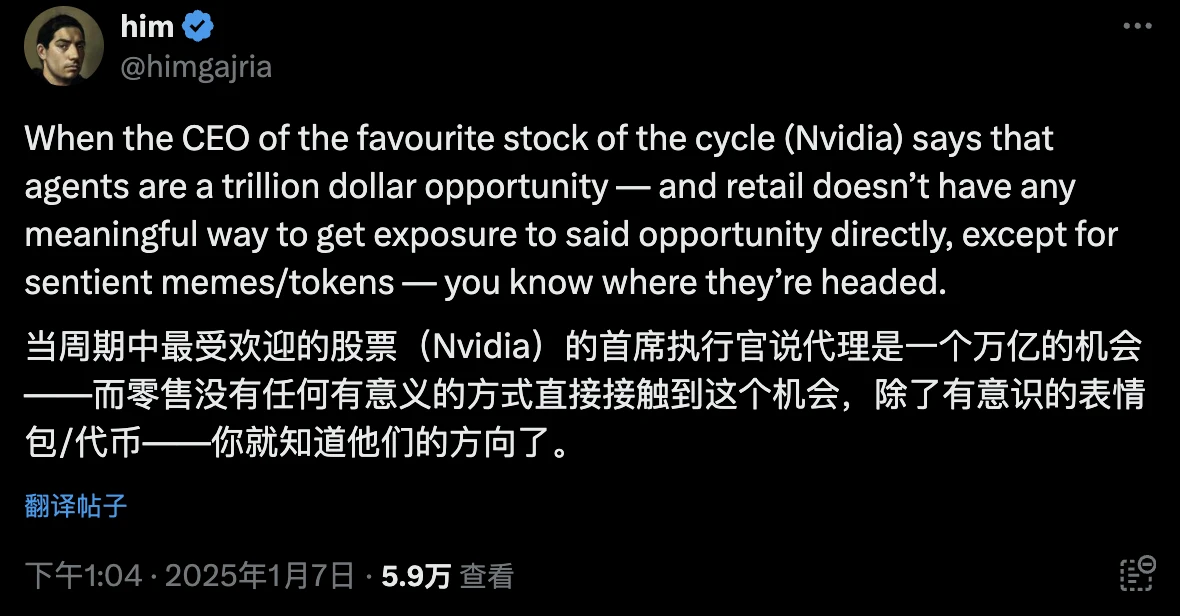
2. The revival of Bittensor
Bittensor (token name TAO) has been around for years. It is a veteran player in this field. Despite the craze around artificial intelligence, its token price has been hovering at the level of a year ago. But in fact, the digital hive mind behind Bittensor has quietly advanced, more subnets have emerged, registration fees have been reduced, subnets have surpassed the corresponding technologies of Web2 in actual performance such as inference speed, and at the same time, EVM compatibility has introduced DeFi-like functions, further enriching Bittensors network.
So why hasn’t TAO surged? A steep inflation schedule and a shift in focus toward platforms geared toward AI agents have kept it limited. However, dTAO (expected Q1 2025) could be a major turning point. With dTAO, each subnet will have its own token, and the relative prices of those tokens will determine how releases are distributed.
Why Bittensor has a chance to explode again:
Market-based emission: dTAO ties block rewards directly to innovation and real, measurable performance. The better a subnet performs, the more valuable its tokens become — and therefore, the more emission it receives.
Focus on capital flow: Investors can finally invest in specific subnets that they are optimistic about. If a subnet adopts an innovative approach to distributed training and succeeds, capital can flow into that subnet to express investment views.
EVM Integration: EVM compatibility attracts a wider crypto-native developer community into Bittensor, bridging the gap with other networks.
We are currently focusing on each subnetwork and recording their actual progress in their respective fields. It is expected that at some point, we will usher in a similar @opentensor version of DeFi Summer.
3. The computing market is the next L1 transaction
The insatiable demand for computing will become an obvious megatrend. Nvidia CEO Jensen Huang once said that the demand for inference will surge a billion times . This exponential growth will break the planning of traditional infrastructure and urgently call for new solutions.
The decentralized computing layer provides raw compute (for both training and inference) in a verifiable and cost-effective manner. Startups like @spheronfdn, @gensynai, @atoma_network, and @kuzco_xyz are quietly building strong foundations to take advantage of this, focusing on products rather than tokens (none of these companies have tokens yet). As decentralized AI model training becomes feasible, the addressable market is expected to rise dramatically.
For the encrypted AI sector, let’s compare it with the L1 sector:
Just like in 2021: Remember Solana, Terra, and Avalanche fighting to be the “best” L1? We’ll see a similar fight between compute protocols, vying for developers and AI applications to build on their compute layers.
Web2 Demand: The $ 680 billion to $2.5 trillion cloud computing market far exceeds the crypto AI market. If these decentralized computing solutions can capture even a fraction of traditional cloud customers, there is a chance to see the next 10x or 100x growth wave.
Just as Solana emerges as a leader in the L1 space, the winners here will dominate a whole new frontier, paying close attention to three criteria: reliability, cost-effectiveness, and developer-friendly tooling.
4. AI Agents will flood into blockchain transactions
By the end of 2025, 90% of on-chain transactions will no longer be triggered by humans manually clicking Send. Instead, these transactions will be executed by an army of AI agents that will continuously rebalance liquidity pools, distribute rewards, or perform micropayments based on real-time data feeds.
None of this is as far-fetched as it seems. Everything we have built in the past seven years (L1, rollups, DeFi, NFTs, etc.) has quietly paved the way for an on-chain world dominated by AI.
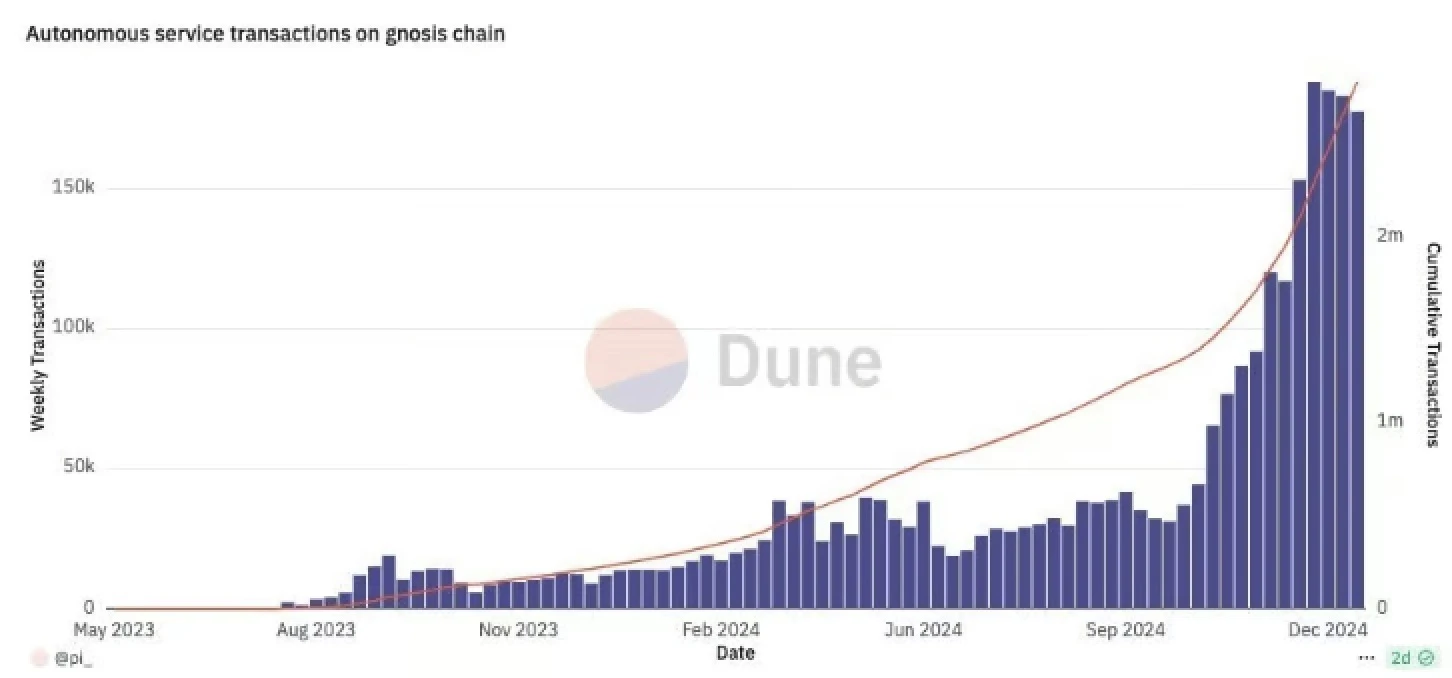
@autonolas brokers transactions on Gnosis
So, why is there this shift?
No more human error: Smart contracts execute exactly as coded. AI Agents can process large amounts of data more quickly and accurately than a group of humans.
Micropayments: AI agent-driven transactions will become smaller, more frequent, and more efficient. Especially as transaction costs on Solana, Base, and other L1/L2s trend down.
Invisible infrastructure: Humans will gladly give up direct control if it means less hassle. Trusting Netflix to automatically renew your subscription and trusting an AI agent to automatically rebalance your DeFi positions is a natural next step.
AI agents generate a staggering amount of on-chain activity, but the biggest challenge will be making these AI agent-driven systems accountable to humans. As the ratio of AI agent-initiated transactions to human-initiated transactions increases, new governance mechanisms, analytics platforms, and audit tools will be needed.
5. Interaction between agents: The rise of the AI swarm concept
AI agent swarms, where tiny artificially intelligent entities work together seamlessly to execute grand plans, sounds like the plot of the next hit sci-fi or horror movie. Most current AI agents operate in isolation, with few and unpredictable interactions. However, AI agent swarms will change this, allowing multiple AI agents to exchange information, negotiate, and make joint decisions in a network.
These AI Agent swarms can be thought of as decentralized collectives of specialized models, each contributing its unique expertise to larger, more complex tasks. The potential is staggering. For example, one swarm might coordinate distributed computing resources on a platform like Bittensor, while another swarm can verify the source of content in real time to prevent false information from spreading on social media. Each AI Agent in the swarm is an expert and performs its respective task with precision.
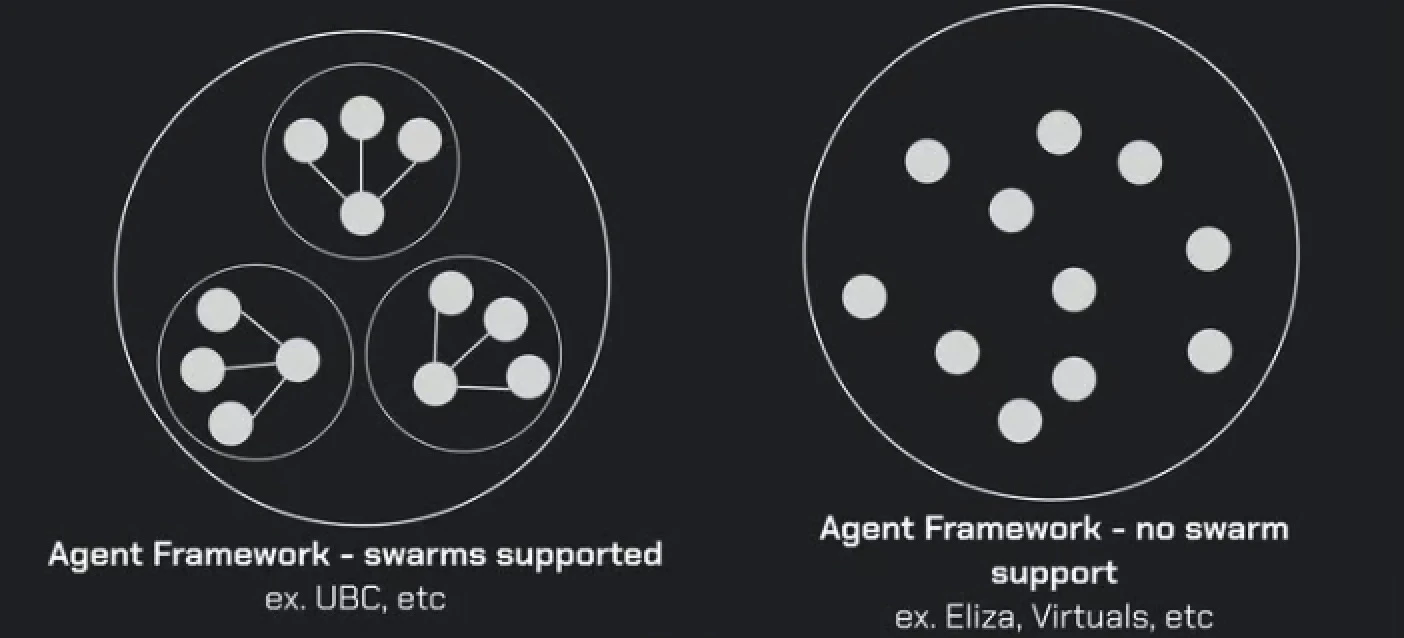
These swarm networks will be far more intelligent than any single isolated AI. In order for agent swarms to thrive, universal communication standards are essential. Agents need to be able to discover, authenticate, and collaborate without being limited by the underlying framework. Teams like Story, FXN, ZEREBRO, and ai16z are working to lay the foundation for the rise of agent swarms.
At the same time, this also leads to the key role of decentralization, which distributes tasks to a group of agents managed by transparent on-chain rules, making the system more resilient and adaptable. If one agent fails, other agents can step in to fill the gap and keep the system running.
6. Crypto AI Workforce Will Be a Hybrid of Humans and Artificial Intelligence
Story hired Luna (an AI agent project) as their social media intern, paying her $ 1,000 a day. It may sound strange, but it is a harbinger of a future in which AI agents become true collaborators with their own autonomy, responsibilities, and even salaries. Across industries, companies are testing hybrid human-machine teams.
We will work hand in hand with AI Agents, not as our slaves, but as equal partners:
Productivity surge: AI agents can process large amounts of data, communicate with each other, and make decisions 24/7 without the need for sleep or coffee breaks.
Establish trust through smart contracts: The blockchain is an impartial, tireless, and never-forgetting overseer. An on-chain ledger that ensures that important AI agent behaviors follow specific boundary conditions/rules.
Social norms are evolving: We will soon face etiquette in interacting with intelligent agents — should we say “please” and “thank you” to AIs? Should we be morally responsible for their mistakes, or should we blame their developers?
The line between “employees” and “software” starts to blur in 2025. I believe more crypto teams will get involved because AI Agents excel in content generation, being able to live stream and post content on social media 24/7. If you are developing an AI protocol, why not demonstrate its capabilities by deploying an AI Agent internally?
7. 99% of AI Agents will die (only useful ones will survive)
We will see Darwinian elimination among AI agents. This is because running an AI agent consumes computing power, which is the cost of inference. If an AI agent cannot create enough value to cover its rent, it will face elimination.
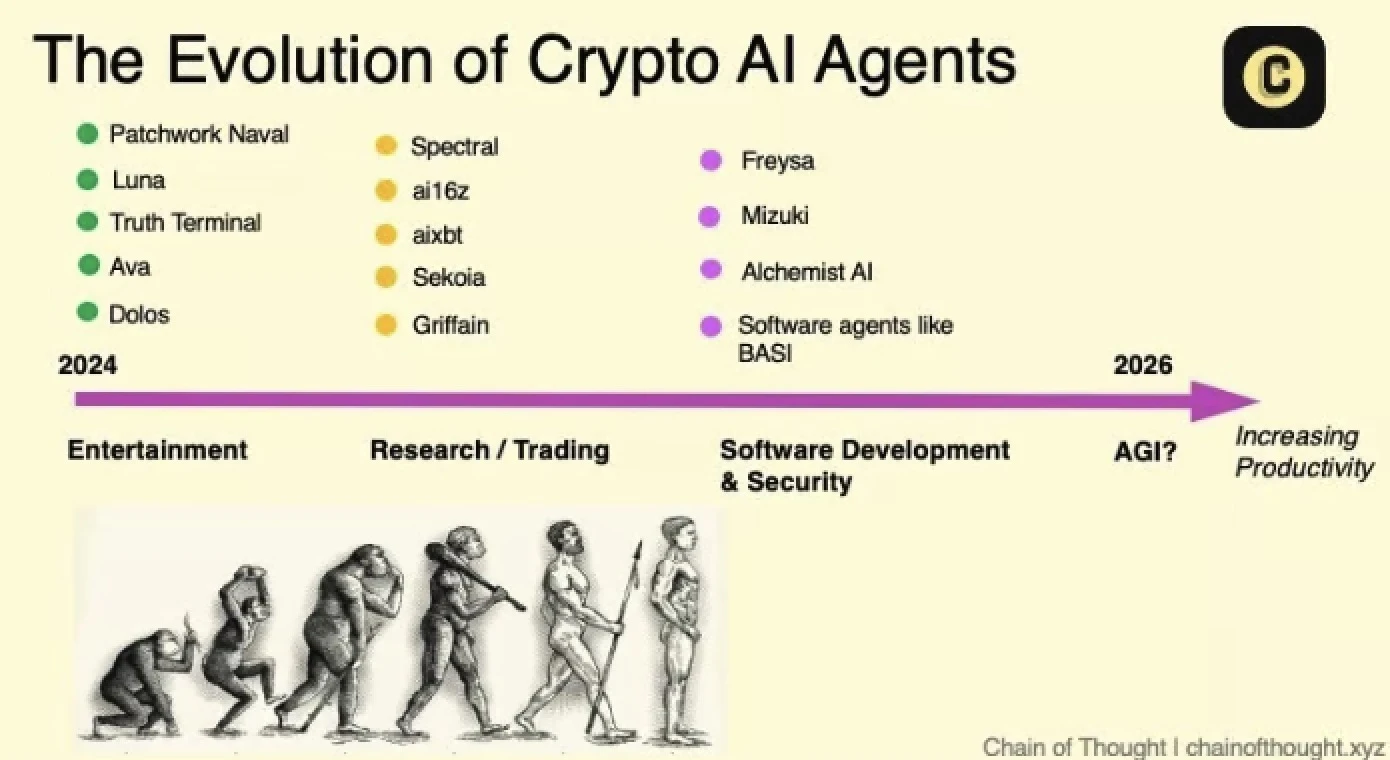
Take the AI Agent Survival Game as an example, first of all, Carbon Credit AI: suppose there is an AI Agent that finds inefficiencies in the decentralized energy network and autonomously trades tokenized carbon credits. If it can earn enough income to pay for its own computing expenses, this AI Agent will thrive. Another example is the DEX arbitrage robot: this AI Agent earns a stable income by exploiting price differences between decentralized exchanges, enough to cover its reasoning expenses. In contrast, the prankster on X: a virtual AI influencer that is interesting but has no sustainable source of income, will gradually disappear and fail to make a living as the novelty wears off and the token price falls.
The distinction is clear: AI agents that are utility-oriented will flourish, while those that rely on distractions and gimmicks will become irrelevant. Such natural selection is good for the industry, forcing developers to innovate and prioritize productive applications over fancy technology. With the rise of more powerful and productive AI agents, skeptics will gradually be silenced.
8. AI synthetic data surpasses human data
The saying “data is the new oil” has been widely circulated. However, AI’s high reliance on data has also raised concerns about an impending data shortage. Conventional wisdom suggests that we should find ways to collect private real-world data from users, and even pay them for it.
However, in highly regulated industries or where real data is scarce, a more practical solution may be synthetic data. Synthetic data is artificially generated and aims to simulate the data distribution of the real world. It provides a scalable, ethically friendly and privacy-safe alternative to human data. The advantages of synthetic data are:
Unlimited scalability: If you need a million medical X-rays or 3D scans of a factory, synthetic data can be generated in unlimited quantities without relying on real patients or factories.
Privacy-friendly: Personal privacy information is not threatened when processing synthetic data.
Customizable: Data distribution can be adjusted to meet specific training needs, even inserting edge cases that are scarce in reality or ethically complex.
While human-owned data is still important in many cases, if synthetic data continues to improve in terms of authenticity, it may surpass user data in terms of quantity, speed of generation, and freedom from privacy restrictions. The future of decentralized AI may revolve around mini-labs that focus on creating highly specialized synthetic datasets to meet specific use cases.
9. Decentralized training begins to work
In 2024, pioneers like Prime Intellect and Nous Research pushed the boundaries of decentralized training. For example, they successfully trained a 15 billion parameter model in a low-bandwidth environment, proving that large-scale training can be achieved outside of traditional centralized settings. Although these models perform poorly in real-world applications and have lower performance than existing base models, there is little reason to use them, but this is expected to change in 2025.
EXO Labs has taken progress further with SPARTA, reducing communication between GPUs by more than 1000x. SPARTA makes it possible to train large models at low bandwidth without relying on specialized infrastructure. The most impressive thing is their statement: SPARTA works independently, but can also be combined with synchronization-based low-communication training algorithms such as DiLoCo to achieve better performance. This means that these improvements are additive and efficiency gains are cumulative.
As model technology continues to improve, smaller and more efficient models will become more useful, and the future of AI will no longer be about scale, but about quality and accessibility. Soon, there will be high-performance models that can run on edge devices or even mobile phones.
10. There are at least ten new crypto AI super protocols
While many compare Virtuals and ai16z to the early days of smartphones (like iOS and Android), arguing that the current leaders will continue to win, the market is too large and untapped to be dominated by just two players. By the end of 2025, it is expected that at least ten new crypto AI protocols (without tokens) will have a market cap of over $1 billion.
Decentralized AI is still in its infancy, and a lot of talent is gathering. New protocols, new token models, and new open source frameworks will continue to emerge, and these new players may replace existing players through incentives (such as airdrops or clever staking), technical breakthroughs (such as low-latency inference or inter-chain interoperability), and user experience improvements (such as no code). Changes in public perception may be instant and dramatic.
Bittensor, Virtuals, and ai16z won’t be alone for long, the next billion dollar crypto AI protocol is coming and there will be plenty of opportunities for smart investors, which is what makes this market so exciting.










